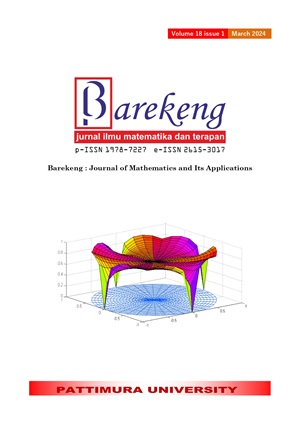MODELING FACTORS AFFECTING EDUCATED UNEMPLOYMENT ON JAVA ISLAND USING GEOGRAPHICALLY WEIGHTED POISSON REGRESSION MODEL
Abstract
The eighth goal of the SDGs, which aim to promote sustained, inclusive and sustainable economic growth, full and productive employment and decent work for all, addresses the problem of unemployment. Indonesia, the fourth-largest country in the world, keeps on dealing with unemployment and its negative consequences. Three provinces on the island of Java have higher unemployment rates for educated people than any other provinces. The purpose of this study is to examine the variables affecting educated unemployment in Java. This study uses cross-sectional data published from BPS-Statistics Indonesia website and the Indonesia Investment Coordinating Board (BKPM) for 119 regencies/cities across six provinces on Java Island in 2021. The predictor variables are Gross Regional Domestic Product (GRDP), investment, labor force participation rate, mean years of schooling, regency/city minimum wage, and inflation. The number of working-age population is used as an exposure measure. Four models were used to analyze the factors affecting educated unemployment on Java Island: Poisson regression model and Geographically Weighted Poisson Regression (GWPR) model, both with and without an exposure. Based on the smallest AIC/AICc, the best model is the GWPR model with an exposure. This model creates 11 groups of locations based on the same predictor variables that significantly affect educated unemployment
Downloads
References
C. Gedikli, M. Miraglia, S. Connolly, M. Bryan dan W. David, “The relationship between unemployment and wellbeing: an updated meta-analysis of longitudinal evidence,” European Journal of Work and Organizational Psychology, vol. 32, no. 1, pp. 128-144, 2023.
C. Panari dan M. Tonelli, “Future Directions in the Research on Unemployment: Protean Career Orientation and Perceived Employability Against Social Disadvantage,” Frontiers in Psychology, vol. 21, no. 701861, 2021.
E. P. Richter, E. Brähler, Y. Stöbel-Richter, M. Zenger dan H. Berth, “The long-lasting impact of unemployment on life satisfaction: results of a longitudinal study over 20 years in East Germany,” Health and Quality of Life Outcomes, vol. 18, no. 361, pp. 1-7, 2020.
S. D. Simpson, “The Cost of Unemployment to the Economy,” 14 April 2022. [Online]. Available: https://www.investopedia.com/financial-edge/0811/the-cost-of-unemployment-to-the-economy.aspx. [Diakses 17 September 2023].
R. F. Putri, “Analisis Pengaruh Inflasi, Pertumbuhan Ekonomi dan Upah Terhadap Pengangguran Terdidik,” Economics Development Analysis Journal, vol. 4, no. 2, pp. 175-181, 2015.
S. Veronika dan A. Y. Mafruhat, “Pengaruh Pertumbuhan Ekonomi, Investasi dan Inflasi terhadap Pengangguran Terdidik di Provinsi Jawa Barat,” Jurnal Riset Ilmu Ekonomi dan Bisnis, vol. 2, no. 2, p. 139–146, 2022.
D. Adriani, N. Hamzah dan J. Zakaria, “Pengaruh Produk Domestik Regional Bruto, Tingkat Pendidikan dan Upah Minimum Terhadap Pengangguran Terdidik,” CESJ: Center Of Economic Students Journal, vol. 2, no. 3, pp. 1-17, 2019.
L. Anselin, Spatial Econometrics: Methods and Models, Dordrecht: Kluwer Academic Publishers, 1988.
A. S. Fotheringham, C. Brundson dan M. Charlton, Geographically Weighted Regression: The analysis of spatially varying relationship, England: John Wiley & Son Ltd, 2002.
S. Mardalena, Purhadi, J. D. T. Purnomo dan D. D. Prastyo, “Bivariate poisson inverse gaussian regression model with exposure variable: infant and maternal death case study,” Journal of Physics: Conference Series, vol. 1752, no. 012016, pp. 1-10, 2021.
E. L. Frome, “The Analysis of Rates Using Poisson Regression Models,” Biometrics, vol. 39, no. 3, pp. 665-674, 1983.
A. C. Cameron dan P. K. Trivedi, Regression analysis of count data, 2nd penyunt., New York: Cambridge University Press., 2013.
R. Winkelmann, Econometric analysis of count data, 5 penyunt., Berlin: Springer, 2008.
T. S. Breusch dan A. R. Pagan, “A Simple Test for Heteroscedasticity and Random Coefficient Variation,” Econometrica, vol. 47, no. 5, pp. 287-1294, 1979.
H. Akaike, “Information theory and an extension of the maximum likelihood principle,” dalam Second International Symposium on Information Theory, Budapest, 1973.
BPS-Statistics, “Statistik Pengangguran 2001-2006,” Jakarta, 2007.
X. Yan dan X. G. Su, Linear regression analysis: Theory and computing, Singapore: World Scientific Publishing Co. Pte. Ltd., 2009.
Copyright (c) 2024 Ditto Satrio Wicaksono, Sinta Nuriyah, Rahajeng Fajritia, Ni Putu Nita Yuniarti, Priatmadani Priatmadani, Laeli Amelia, Sarni Maniar Berliana

This work is licensed under a Creative Commons Attribution-ShareAlike 4.0 International License.
Authors who publish with this Journal agree to the following terms:
- Author retain copyright and grant the journal right of first publication with the work simultaneously licensed under a creative commons attribution license that allow others to share the work within an acknowledgement of the work’s authorship and initial publication of this journal.
- Authors are able to enter into separate, additional contractual arrangement for the non-exclusive distribution of the journal’s published version of the work (e.g. acknowledgement of its initial publication in this journal).
- Authors are permitted and encouraged to post their work online (e.g. in institutional repositories or on their websites) prior to and during the submission process, as it can lead to productive exchanges, as well as earlier and greater citation of published works.






1.gif)



